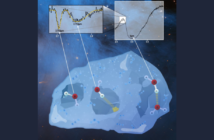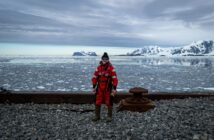In a style all of her own, Professor Monica Grady took part in a radio panel discussion covering everything from gravitational waves and scientific theories to wobbly bits.
On Broadcasting House, the Radio 4 magazine style programme on Sunday mornings, Professor Grady was joined by fellow scientist Professor John Butterworth from University College London. They had been invited to talk about what scientific theories they would like to have proven in their lifetime, but also to don their teaching hats and mark some Radio 4 listeners’ homework.
Following confirmation last week by astrophysicists that gravitational waves do exist, the listeners of the Radio 4 programme were invited to share their understanding of what gravitational waves were. Through much laughter and a light-hearted approach, the two professors gave the statements a mark out of ten.
The analogy that got the highest mark compared space to a pond and a pebble to a black hole.
“It’s like when you throw a pebble into a pond except the pebble is a black hole and the pond is space.”
Far from being scientific, this suggestion correctly acknowledged that the ripples radiate symmetrically in every direction from an object that is accelerating causing waves.
“Mars is moist”
As the discussion flowed into which theory each scientist would like to see proved in their lifetime, the humour also continued to flow. When Professor Butterworth was asked to present the theory that he would like proven in his life time, there was an awkward pause. A zip was unzipped and Monica says “Wow” as he unveils a T-Shirt showing the Hadron Collider and explains that he would like a greater understanding about dark matter.
Professor Grady’s wish was to answer the question “is there life beyond Earth?” She had a bottle of water with her to prove that steps had been taken to partly answer this question. She explained that we know that there is water on Mars in the form of ice, which also means bacteria can survive but the possibilities are enormous for other planets, moons and stars. Monica was clear that we will eventually see life on Mars but it will almost undoubtedly be terrestrial rather than Martian life.
Cooperative working
The discovery of the gravitational waves was primarily a US-based experiment but it was very much a cooperative international effort. It highlighted the importance of cooperative, international resources for example CERN and other telescopes. It also highlights the need for a continuity of vision as the theory of gravitational waves was first debated by Albert Einstein in his theory of relativity.
And finally….
Towards the end of the section, the final few attempts from listener’s to explain gravitational waves were read out. These included:
“Invisible wobbly bits”
“Gravy plus tea equals gravi-tea”
Professor Grady concluded the discussion with her own inimitable take on “wobbly bits”!
The full discussion can be listened to here (discussion from 07:50 – 18:00) – only available until 12 March 2016



